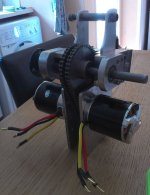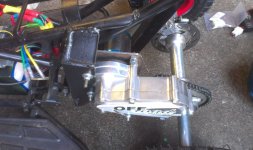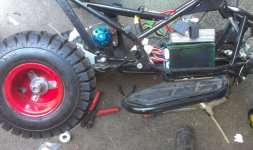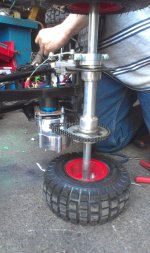gwhy!1
100 kW
billsy said:Kevin I can't believe I'm only seeing this thread now. I need to pop round for a catch up. Its looking good bud.
hiya mate,
you can pop round anytime.
billsy said:Kevin I can't believe I'm only seeing this thread now. I need to pop round for a catch up. Its looking good bud.




bzhwindtalker said:So how is the pocket bike tranny working out? did you get the clutch working? All I could do with one of those is relase 1800w of heat with the clutch stalled...
Jeremy Harris said:Neat. I'm looking forward to how this double motor setup works, as I have plans to fit two 80-100 motors to a common shaft for my motorcycle build. My layout would be pretty similar to this, with the motors tucked up where the old airbox was and the layshaft just in front of the swing arm bearings.
gwhy! said:Thought I would share one of my solutions for a fuse holder/antispark connection, each fuse can be 30A so its quite configurable so 90A per total fuse, a pullable link could be used for quick disconnect. I will be using 2 of them as I am running 2 controllers.
im not totally sure that 2x80-100 are needed for a small road going bike but I spose it depends what you want your top speed to be.
gwhy! said:Here is a diagram of the internals. the fuse holders are stackable, and the value of the resistor (3W) was selected to gently pre-charge the caps in the controller and not produce to much heat if the link was not connected.
im not totally sure that 2x80-100 are needed for a small road going bike but I spose it depends what you want your top speed to be.
...the other advantage of the smaller motors is the no load current is only a tad over 5A for both motors, and if I were using the bigger motors this will be more like 11-12A...
deVries said:...the other advantage of the smaller motors is the no load current is only a tad over 5A for both motors, and if I were using the bigger motors this will be more like 11-12A...
Why is the no-load current so much higher than what is advertised for each motor??? Or, is that accurate as spec'd ?
Thanks.

dnmun said:would love to see your circuit drawings for it or is this gonna be proprietary? why did you put the extra 3 pin plug in parallel? is that for monitoring it while working on it?
dnmun said:neato. i don't know picaxe, but just bot some junk that has a pic16... chip on it to control the board, so that may be the processor module. i should read more. is there a good wiki spot?
so instead of the resistor in the base of the throttle line the picaxe will have an output equal to that offset, and then be able to provide the full 4.7V to the controller without shutting off the controller from high voltage default protection. and you just use the 5V supply for the picaxe.
